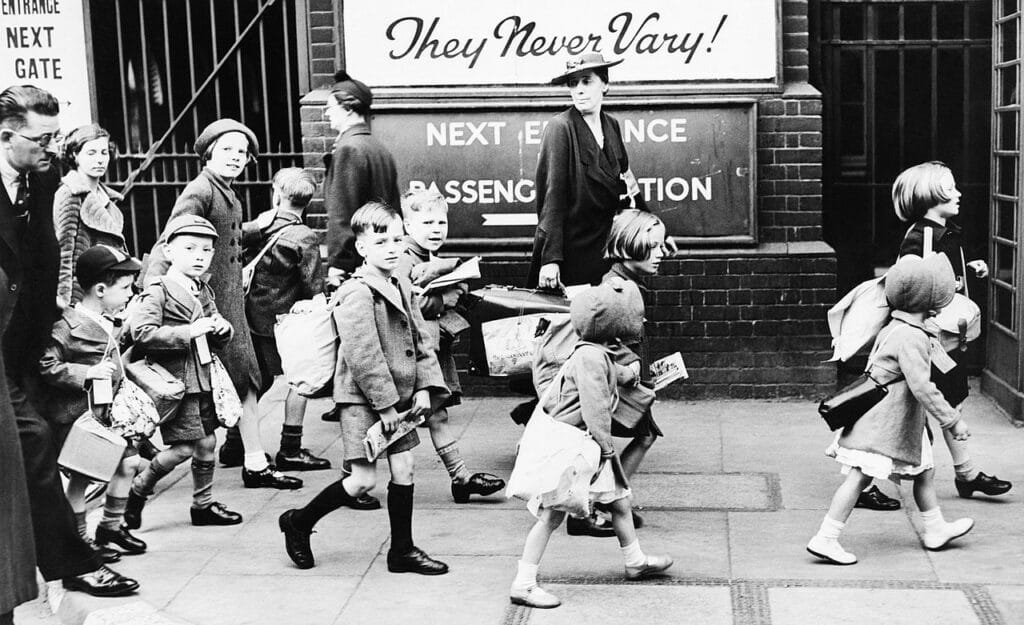The 1940s in Britain were a tumultuous decade, dominated by the Second World War. While the stories of soldiers on the front lines are often told, the experiences of children on the home front are equally compelling and paint a vivid picture of resilience, adaptation, and profound change. For an entire generation, childhood wasn’t just about games and school; it was lived “under siege,” shaped by air raids, rationing, and an unwavering sense of national duty.
The Evacuation: A Journey into the Unknown
One of the most significant and defining experiences for countless British children was evacuation. As the threat of German bombing raids loomed large, particularly over major cities, the government initiated a massive relocation programme. Children, often clutching a gas mask box and a small suitcase, were separated from their families and sent to safer rural areas, or even overseas to countries like Canada and the USA. You can read more about the official evacuation scheme on the Imperial War Museums website.
For many, evacuation was a bewildering and often traumatic experience. Placed with strangers, sometimes in vastly different social environments, these young evacuees faced a mix of kindness and, occasionally, hardship. The emotional toll of separation from parents, siblings, and familiar surroundings was immense. Yet, for some, it offered unexpected opportunities: fresh air, new friendships, and a glimpse into a different way of life. The stories of evacuation highlight the incredible adaptability of children, who often found ways to thrive even in profoundly unsettling circumstances.
Daily Life Under the Bombs: Air Raids and Anderson Shelters
Life for children who remained in urban areas was dramatically altered by the constant threat of air raids. The wail of the air raid siren became a chillingly familiar sound, sending families scrambling for the safety of Anderson shelters in their gardens or public communal shelters. These cramped, damp spaces became temporary homes, where families would huddle together, listening to the drone of enemy aircraft and the terrifying thud of bombs falling.
Schooling was frequently disrupted. Many schools were damaged or destroyed, and those that remained often operated in shifts or within the confines of air raid shelters. Lessons might be punctuated by the need to “take cover,” and the curriculum often incorporated wartime themes, from understanding gas masks to recognising enemy aircraft. Playgrounds, once bustling with energy, sometimes bore the scars of recent attacks, a stark reminder of the ever-present danger. Despite the fear, children developed a remarkable sense of normalcy amidst the chaos, finding ways to play and learn even as their world was literally shaking around them.
Wartime Play: Games, Toys, and Resourcefulness
Even in the darkest of times, children’s innate need for play persisted. While new toys were scarce due to rationing and the redirection of manufacturing towards the war effort, creativity flourished. Marbles, skipping ropes, and hopscotch remained popular, often played in the street or on bomb sites. Children fashioned their own entertainment from everyday objects: conkers became fierce weapons, matchboxes transformed into cars, and scraps of fabric turned into dolls’ clothes.
Wartime themes permeated playtime. Children would mimic air raids with toy planes, dig “trenches” in their gardens, and set up mock air raid patrols. Propaganda and national duty were often subtly woven into children’s media, from comic books depicting heroic pilots to radio programmes encouraging thriftiness and resilience. These games, far from being trivial, served as a vital outlet for processing the anxieties of war and reaffirming a sense of control in an unpredictable world.
Little Soldiers on the Home Front: Children’s Contribution to the War Effort
Children were not passive observers of the war; they actively participated in the national effort, often with immense enthusiasm. Scrap drives were a common sight, with children meticulously collecting everything from old pots and pans to rubber and paper, all destined to be recycled for armaments. They knitted scarves and socks for soldiers, tended “Dig for Victory” allotments to supplement meagre rations, and collected Rosehips for their high vitamin C content, which was vital during a period of limited fresh fruit. More details on the “Dig for Victory” campaign can be found on the National Archives website.
These contributions instilled a strong sense of patriotism and responsibility. Children understood, in their own way, that they were doing their bit to help win the war. Their efforts, often small but collectively significant, highlighted the pervasive spirit of national unity and the way the entire population, regardless of age, was mobilised for the war effort.
The Lasting Scars: Psychological Effects and a Changed Generation
While British children displayed remarkable resilience, the war undeniably left long-lasting psychological effects. Exposure to trauma, the disruption of family life, and the constant threat of danger contributed to anxiety, nightmares, and, for some, more severe emotional distress. The sheer scale of death and destruction witnessed by many children, particularly in bombed cities, left an indelible mark.
However, the war also forged a generation characterised by self-reliance, resourcefulness, and a strong sense of community. They emerged from their “childhood under siege” with a unique perspective, often more mature and pragmatic than their pre-war counterparts. The experiences of the 1940s profoundly shaped their values, their approach to austerity, and their determination to build a better, more peaceful future. Understanding this generation’s wartime childhood is crucial to comprehending the social and cultural landscape of post-war Britain. For further reading, consider exploring personal accounts from the BBC’s WWII People’s War archive.
Image: London schoolchildren off to the west of England. Photo shows: Children arriving at a London station this morning to leave for the West Country. Image WikiMedia Commons
